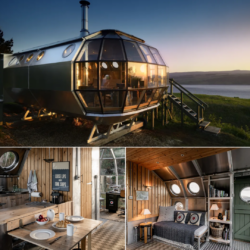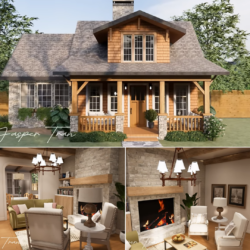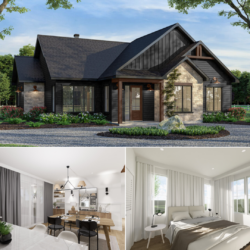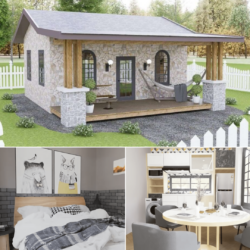
In the realm of inventive architecture and sustainable living, the tiny home movement has taken a fascinating turn. As more and more people seek to reduce their ecological footprint and embrace minimalism, we’ve seen a wave of innovative conversions.
School buses, shipping containers, and even old train cars have been transformed into comfortable living spaces. The latest entrant in this creative trend is perhaps the most thrilling one yet – decommissioned helicopters being converted into stylish and fully functional tiny homes.

This novel concept is lifting the tiny home movement to new altitudes, both literally and figuratively.
The Genesis of an Idea
At first glance, the idea of converting a helicopter into a living space might seem like an outlandish concept, something that belongs in the pages of a science fiction novel or a futurist’s notebook. But it is, in fact, a reality that is captivating tiny home enthusiasts and design innovators around the globe.



The unique aesthetics of a helicopter, coupled with the challenge of turning such a compact and unconventional space into a comfortable dwelling, makes this a captivating prospect for those seeking to push the boundaries of alternative living.
The Art of Transformation: From Rotorcraft to Residence
Transforming a helicopter into a tiny home is an exercise in design creativity, architectural prowess, and strategic planning. Every square inch matters, and each element of the interior must be thoughtfully curated to maximize space without compromising on comfort or functionality.

The original structure of the helicopter is typically maintained to preserve the unique aesthetic that makes these tiny homes so distinctive. The interior, however, undergoes a total metamorphosis. Designers and homeowners have come up with ingenious ways to integrate living amenities into the limited space.
The helicopter’s cockpit, once home to a plethora of controls and navigation systems, often doubles as a lounge or a study, offering panoramic views that are unrivaled by any conventional dwelling. The main body or cabin, previously designed to carry passengers or cargo, is now divided into a fully-equipped kitchen, a compact yet functional bathroom, and a cozy sleeping area.

Through the clever use of foldable and multifunctional furniture, these spaces can serve multiple purposes, providing the necessary flexibility that tiny home living requires. The tail section of the helicopter, often used for storage in active service, can be repurposed into additional living space or retain its original function as a storage area.
Navigating Challenges: The Road to Aerial Living
While the transformation of a helicopter into a tiny home is indeed an exciting endeavor, it’s not without its unique set of challenges. These difficulties stretch beyond the conventional obstacles of tiny home living, demanding innovative solutions.

The structural integrity of the helicopter, a paramount factor in the conversion process, must be meticulously preserved. Helicopters, unlike traditional homes or even other vehicles commonly converted into homes like buses or vans, are not designed for constant human habitation. Retrofitting a helicopter while ensuring it remains structurally sound is a delicate task that requires expert attention.
Furthermore, integrating necessary amenities such as plumbing and electricity calls for innovative engineering solutions. Heat insulation is another challenge to tackle, as the original materials used in helicopters are not designed to regulate temperature like traditional home-building materials. Designers and homeowners often have to find creative ways to install insulation without compromising the space or the aesthetics of the home.
Regulations and Legalities: Navigating the Legal Landscape
Before embarking on the exciting journey of transforming a helicopter into a home, it’s essential to understand the legal and zoning regulations associated with such a unique project. Laws regarding tiny homes, especially ones as unconventional as a helicopter, can vary widely depending on location.

It’s crucial to conduct thorough research and consult with local authorities or a legal advisor to understand what permits are required, what zoning laws apply, and whether there are any restrictions on using a decommissioned helicopter as a residence. This due diligence is an important step in ensuring your soaring dream doesn’t encounter turbulence in the form of legal roadblocks.
The Cost of Adventure: Financial Considerations
The financial aspect of converting a helicopter into a habitable space is another factor to consider. The cost can be substantial, with expenses including the initial acquisition of a decommissioned helicopter, the cost of materials and labor for the conversion, and the ongoing maintenance costs.



These helicopters, after all, were not originally intended to serve as homes, so upkeep can involve unique challenges and expenses.
However, for those who value the unique charm, character, and statement that a helicopter home makes, these costs are seen as an investment in a lifestyle choice rather than a financial burden. Plus, there’s the priceless value of owning a home that truly stands out from the crowd.
Mobility and Freedom: Taking Your Home Places
While the converted helicopter may not be able to take to the skies, it doesn’t mean it’s grounded forever. Many helicopter homeowners choose to mount their unconventional dwellings on trailers or other mobile platforms.

This allows them the freedom to relocate their homes whenever the call of the open road (or open skies, in this case) beckons. In this sense, helicopter homes continue to offer a sense of mobility and freedom, even after their flying days are over.
Conclusion: The Sky’s the Limit
Helicopter tiny homes are a testament to human creativity, resourcefulness, and the spirit of the tiny home movement and one of the companies working in the space right now is Glampinghelicopter.com.
So, are you ready to join the revolution and let your dreams take flight in a helicopter tiny home? Why merely live on the land when you can live in the sky? If you’ve ever dreamed of a life less ordinary, a helicopter home might just be the dwelling you’ve been waiting for. Welcome to the future of tiny home living – it’s looking up!





